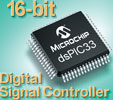

Microchip claims its new dsPIC33 family of digital signal controllers (DSCs) offers high levels of performance, memory and I/O without the complexity of traditional digital signal processors (DSPs).
The dsPIC33 architecture is well-suited for embedded control, providing deterministic operation and sustained performance in an interrupt-intensive control environment.
The dsPIC33 family operates at 40 MIPS from a 3,3 V supply, with up to 256 KB of self-programming Flash and up to 30 KB of RAM in 64- to 100-pin packages. The new family of 27 devices, in addition to the 21 existing dsPIC30 products, demonstrates Microchip's commitment to the 16-bit market.
The dsPIC33 family is compatible with the existing dsPIC30 family - it has the same instruction set, pinouts, and uses the same development tools, including the MPLAB IDE and the MPLAB C30 C compiler - but offers an attractive feature-set for applications requiring larger Flash and RAM, where extra I/O is important, or where 3,3 V is the preferred chip voltage.
Two dsPIC33 families
Microchip's two initial dsPIC33 product families (general purpose DSCs and motor control and power conversion DSCs) also feature direct memory access and (serial I/O subsystems, including up to two each: SPI, I²C, UART and CAN.
The general-purpose DSCs are ideal for a broad range of applications, including speech and audio, soft modem, security and medical products. The 15 initial dsPIC33 general-purpose devices include: one or two 500 Ksps, 12-bit ADCs; Codec interface.
The Motor-Control and Power-Conversion DSCs are targeted at a range of motor control and power conversion applications, such as washing machines, electronic power steering, environmental control, UPS, inverters and LED lighting arrays. The 12 initial devices include: one or two 1,1 Msps 10-bit ADCs; up to eight sample-and-holds for simultaneous sampling; specialised PWM for motor-control, lighting and power-conversion applications; quadrature encoder interface.
Development support
Within the MPLAB IDE, Microchip says that high-level resources have been added to allow the DSC features to be used with minimal effort. These include its Visual Device Initialiser, which can generate initialisation code in a few clicks, and the Motor Control GUI, which can be used to quickly tune dsPIC DSC motor control libraries to a specific motor type.
In addition, sophisticated libraries have been developed that fully exploit the dsPIC DSC's capabilities while presenting a user-friendly environment for engineers. Many of these libraries are free, while others can be licensed for a small one-time fee. To assist with the use of digital filters, the low-cost Digital Filter Designer and the free dsPICworks software can help users define filters to their specifications, simulate performance and generate code, all without the need for extensive DSP expertise.
| Tel: | +27 11 923 9600 |
| Email: | [email protected] |
| www: | www.altronarrow.com |
| Articles: | More information and articles about Altron Arrow |
| Email: | [email protected] |
| www: | |
| Articles: | More information and articles about Tempe Technologies |

© Technews Publishing (Pty) Ltd | All Rights Reserved